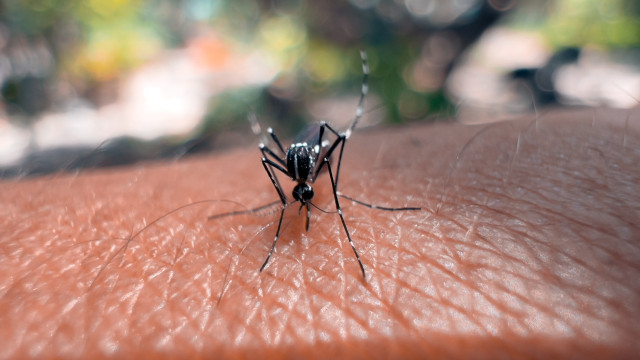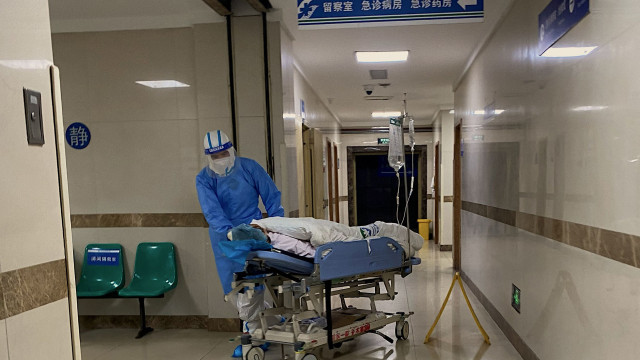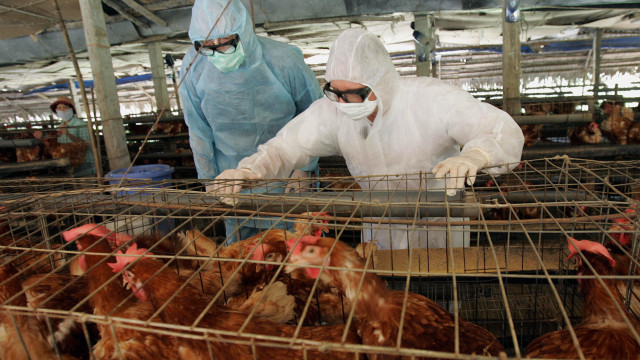






























See Also
See Again
© Shutterstock
0 / 31 Fotos
Eating disorders in young people
- When it comes to eating disorders, such as anorexia and bulimia, most people associate them with young adults.
© Shutterstock
1 / 31 Fotos
Common belief
- Indeed, even people who have experienced an eating disorder first-hand tend to believe that they are the reserve of teenagers and people in their early 20s.
© Shutterstock
2 / 31 Fotos
Challenging assumptions
- However, there is a growing body of evidence that suggests later-in-life eating disorders may be much more common than we might think.
© Shutterstock
3 / 31 Fotos
Eating disorders and the menopause
- In particular, scientists are beginning to explore the connection between menopause and eating disorders in women.
© Shutterstock
4 / 31 Fotos
Growing body of knowledge
- Historically this has been a woefully understudied topic, but in 2025 that is slowly beginning to change.
© Shutterstock
5 / 31 Fotos
Truth in what people believe
- The notion that eating disorders are a young woman’s affliction is, to a certain extent, true.
© Shutterstock
6 / 31 Fotos
Biological changes during puberty
- In their teens and early 20s, women experience major biological changes. Their hormones are all over the place, and the body undergoes major physical changes.
© Shutterstock
7 / 31 Fotos
Psychological shifts
- During this period, women also tend to experience significant psychological shifts, for example, related to their sense of identity, as well as considerable external pressure.
© Shutterstock
8 / 31 Fotos
Combination of factors
- While it is impossible to pinpoint a single reason that a young woman may develop an eating disorder, a combination of all these factors may increase her risk.
© Shutterstock
9 / 31 Fotos
Parallel changes during menopause
- To a large extent, the changes that women go through during puberty are mirrored during menopause.
© Shutterstock
10 / 31 Fotos
Significant upheaval
- Instead of getting their periods, women get hot flashes. It is a time of significant biological change and upheaval.
© Shutterstock
11 / 31 Fotos
Even greater risk
- Arguably, women in their 40s and 50s have to deal with more external pressures than their younger selves, which could even put them at greater risk of developing an eating disorder.
© Getty Images
12 / 31 Fotos
More external pressures
- For example, many women going through perimenopause or menopause have to care for children or aging parents.
© Shutterstock
13 / 31 Fotos
Added complication - It is also during this period that many women start, unfortunately, to experience age discrimination in the workplace.
© Shutterstock
14 / 31 Fotos
The role of social media
- Add the pressure from social media into the mix, and menopause becomes a transition that is even trickier to navigate.
© Shutterstock
15 / 31 Fotos
Disparity in the availability of data
- While there is a wealth of data that informs the treatment of eating disorders among girls going through puberty, the corresponding data for women going through menopause is almost non-existent.
© Shutterstock
16 / 31 Fotos
Recent development
- Indeed, it is only in the past few months and years that medical professionals have started to pay attention to this problem.
© Shutterstock
17 / 31 Fotos
Expert opinion
- In 2005, psychologist and author Margo Maine wrote her first book on the topic of midlife eating disorders.
© Shutterstock
18 / 31 Fotos
Minimal progress in 20 years
- In 2025, she told Women’s Health, the available data is basically the same. There may be more awareness, but nothing is really changing.
© Shutterstock
19 / 31 Fotos
More data and insights needed
- With more data and insights, experts would be able to offer eating disorder treatments that are better tailored to women going through perimenopause and menopause.
© Shutterstock
20 / 31 Fotos
Adopting a tailored approach
- It is very important to adopt a tailored approach, because treatment can be a lot more complicated for women in their 40s and 50s than for girls in their teens.
© Shutterstock
21 / 31 Fotos
Inpatient treatment more complicated
- For instance, it can be much more difficult to take time out of a daily routine to attend an inpatient treatment facility.
© Shutterstock
22 / 31 Fotos
The role of outpatient programs
- Experts believe that one way forward would be to offer better outpatient programs for mature women with eating disorders.
© Shutterstock
23 / 31 Fotos
The status quo
- As it stands, many outpatient groups are filled with younger women, and it can be difficult for older women to benefit from this environment.
© Shutterstock
24 / 31 Fotos
Renfew Center
- One eating disorder treatment center that is making this change is the Renfew Center, which has 19 locations across the United States.
© Shutterstock
25 / 31 Fotos
Specific group therapy
- Renfew offers group therapy for older adults, where women can discuss the experience of living with an eating disorder later in life.
© Shutterstock
26 / 31 Fotos
Awareness among professionals
- If there is going to be meaningful change, there also needs to be better awareness among medical professionals.
© Shutterstock
27 / 31 Fotos
As it currently stands
- As it stands, many doctors miss the signs of eating disorders that are triggered by menopause, which can result in patients slipping through the cracks.
© Shutterstock
28 / 31 Fotos
Social awareness
- Finally, it is important that we continue to raise awareness at a social level and shine a light on a topic that has for so long been ignored.
© Shutterstock
29 / 31 Fotos
Recognizing the signs
- By recognizing the signs in yourself or in a loved one, you can help locate the proper treatment and get on the path toward recovery. Sources: (Women's Health) (Independent) See also: What is menopause brain fog?
© Shutterstock
30 / 31 Fotos
© Shutterstock
0 / 31 Fotos
Eating disorders in young people
- When it comes to eating disorders, such as anorexia and bulimia, most people associate them with young adults.
© Shutterstock
1 / 31 Fotos
Common belief
- Indeed, even people who have experienced an eating disorder first-hand tend to believe that they are the reserve of teenagers and people in their early 20s.
© Shutterstock
2 / 31 Fotos
Challenging assumptions
- However, there is a growing body of evidence that suggests later-in-life eating disorders may be much more common than we might think.
© Shutterstock
3 / 31 Fotos
Eating disorders and the menopause
- In particular, scientists are beginning to explore the connection between menopause and eating disorders in women.
© Shutterstock
4 / 31 Fotos
Growing body of knowledge
- Historically this has been a woefully understudied topic, but in 2025 that is slowly beginning to change.
© Shutterstock
5 / 31 Fotos
Truth in what people believe
- The notion that eating disorders are a young woman’s affliction is, to a certain extent, true.
© Shutterstock
6 / 31 Fotos
Biological changes during puberty
- In their teens and early 20s, women experience major biological changes. Their hormones are all over the place, and the body undergoes major physical changes.
© Shutterstock
7 / 31 Fotos
Psychological shifts
- During this period, women also tend to experience significant psychological shifts, for example, related to their sense of identity, as well as considerable external pressure.
© Shutterstock
8 / 31 Fotos
Combination of factors
- While it is impossible to pinpoint a single reason that a young woman may develop an eating disorder, a combination of all these factors may increase her risk.
© Shutterstock
9 / 31 Fotos
Parallel changes during menopause
- To a large extent, the changes that women go through during puberty are mirrored during menopause.
© Shutterstock
10 / 31 Fotos
Significant upheaval
- Instead of getting their periods, women get hot flashes. It is a time of significant biological change and upheaval.
© Shutterstock
11 / 31 Fotos
Even greater risk
- Arguably, women in their 40s and 50s have to deal with more external pressures than their younger selves, which could even put them at greater risk of developing an eating disorder.
© Getty Images
12 / 31 Fotos
More external pressures
- For example, many women going through perimenopause or menopause have to care for children or aging parents.
© Shutterstock
13 / 31 Fotos
Added complication - It is also during this period that many women start, unfortunately, to experience age discrimination in the workplace.
© Shutterstock
14 / 31 Fotos
The role of social media
- Add the pressure from social media into the mix, and menopause becomes a transition that is even trickier to navigate.
© Shutterstock
15 / 31 Fotos
Disparity in the availability of data
- While there is a wealth of data that informs the treatment of eating disorders among girls going through puberty, the corresponding data for women going through menopause is almost non-existent.
© Shutterstock
16 / 31 Fotos
Recent development
- Indeed, it is only in the past few months and years that medical professionals have started to pay attention to this problem.
© Shutterstock
17 / 31 Fotos
Expert opinion
- In 2005, psychologist and author Margo Maine wrote her first book on the topic of midlife eating disorders.
© Shutterstock
18 / 31 Fotos
Minimal progress in 20 years
- In 2025, she told Women’s Health, the available data is basically the same. There may be more awareness, but nothing is really changing.
© Shutterstock
19 / 31 Fotos
More data and insights needed
- With more data and insights, experts would be able to offer eating disorder treatments that are better tailored to women going through perimenopause and menopause.
© Shutterstock
20 / 31 Fotos
Adopting a tailored approach
- It is very important to adopt a tailored approach, because treatment can be a lot more complicated for women in their 40s and 50s than for girls in their teens.
© Shutterstock
21 / 31 Fotos
Inpatient treatment more complicated
- For instance, it can be much more difficult to take time out of a daily routine to attend an inpatient treatment facility.
© Shutterstock
22 / 31 Fotos
The role of outpatient programs
- Experts believe that one way forward would be to offer better outpatient programs for mature women with eating disorders.
© Shutterstock
23 / 31 Fotos
The status quo
- As it stands, many outpatient groups are filled with younger women, and it can be difficult for older women to benefit from this environment.
© Shutterstock
24 / 31 Fotos
Renfew Center
- One eating disorder treatment center that is making this change is the Renfew Center, which has 19 locations across the United States.
© Shutterstock
25 / 31 Fotos
Specific group therapy
- Renfew offers group therapy for older adults, where women can discuss the experience of living with an eating disorder later in life.
© Shutterstock
26 / 31 Fotos
Awareness among professionals
- If there is going to be meaningful change, there also needs to be better awareness among medical professionals.
© Shutterstock
27 / 31 Fotos
As it currently stands
- As it stands, many doctors miss the signs of eating disorders that are triggered by menopause, which can result in patients slipping through the cracks.
© Shutterstock
28 / 31 Fotos
Social awareness
- Finally, it is important that we continue to raise awareness at a social level and shine a light on a topic that has for so long been ignored.
© Shutterstock
29 / 31 Fotos
Recognizing the signs
- By recognizing the signs in yourself or in a loved one, you can help locate the proper treatment and get on the path toward recovery. Sources: (Women's Health) (Independent) See also: What is menopause brain fog?
© Shutterstock
30 / 31 Fotos
The connection between menopause and eating disorders
A previously understudied topic
© Shutterstock
When it comes to eating disorders, it is important to remember they can strike at any age. In general, there is no single reason that a person develops an eating disorder. Rather, they occur as a result of a combination of factors.
However, there is evidence to suggest that periods of biological and psychological upheaval may carry an increased risk of a person developing a disorder, such as bulimia or anorexia. And in women this not only includes puberty, but menopause too.
Curious? Check out this gallery to find out more.
RECOMMENDED FOR YOU




































MOST READ
- Last Hour
- Last Day
- Last Week








